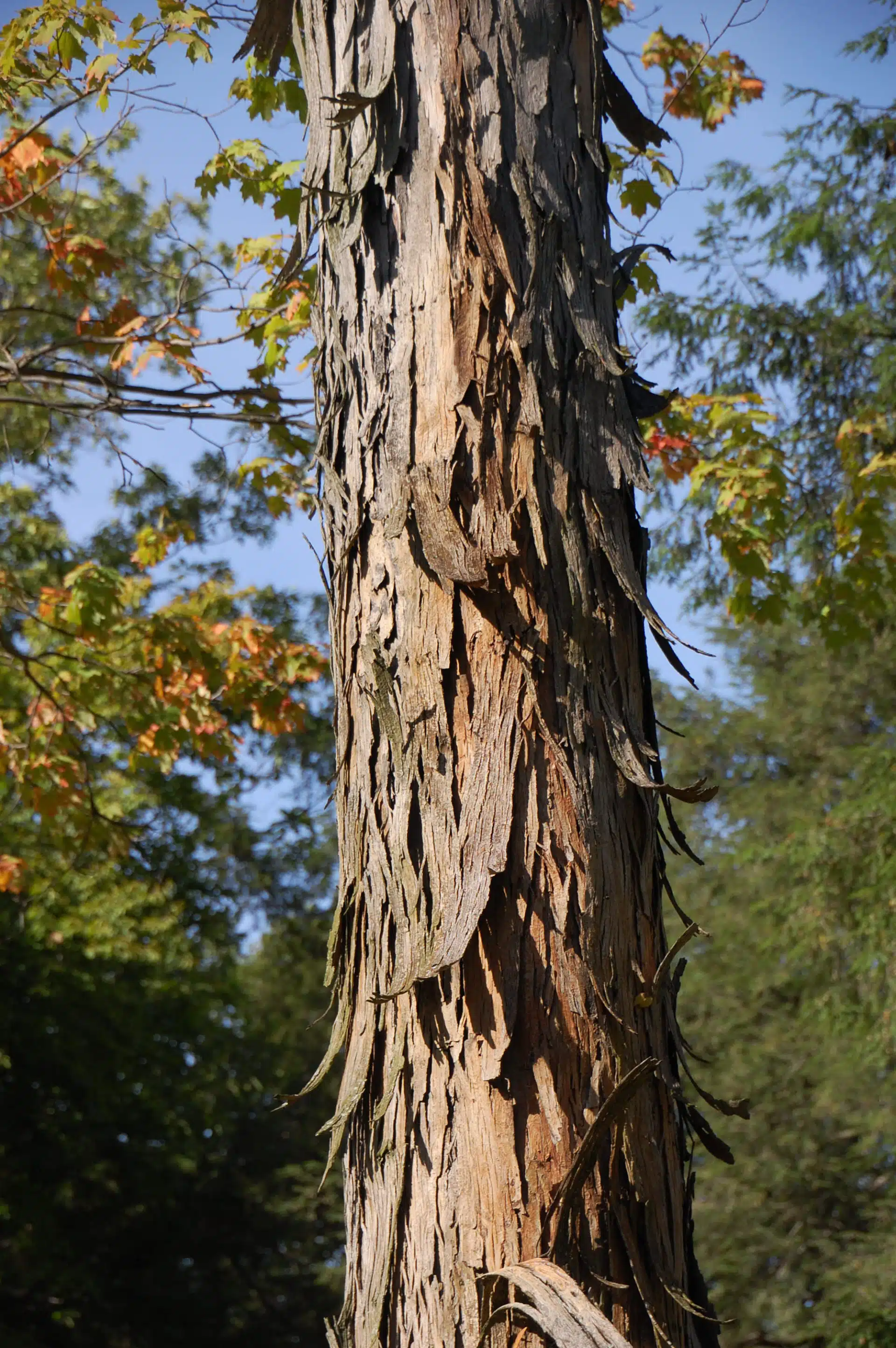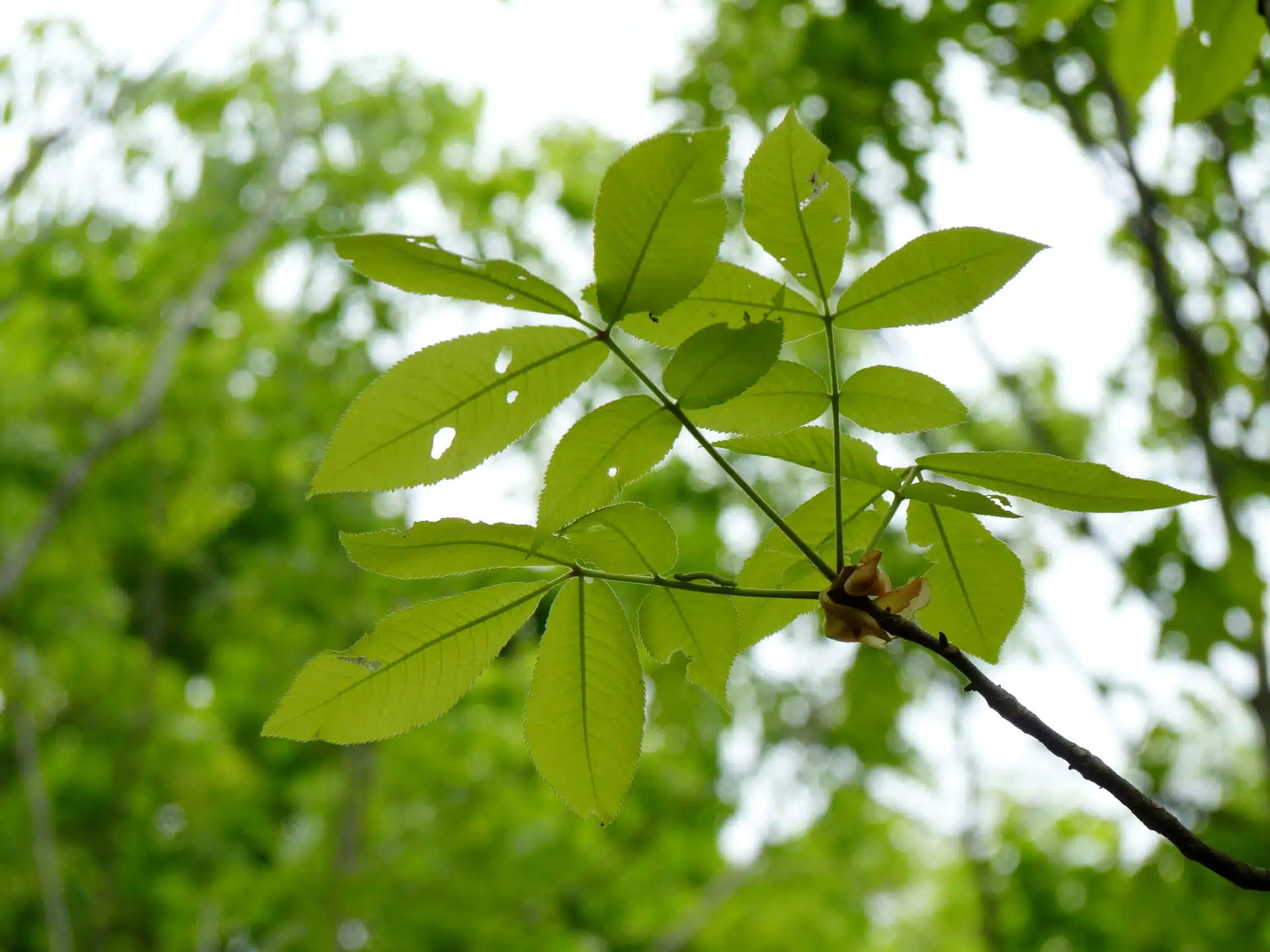Trees
Shagbark hickory
Carya ovata


Carya ovata, a ruggedly handsome tree, is native to eastern North America from Iowa to Quebec, south to Texas and Georgia. Disjunct populations occur in the mountains of northeastern Mexico. It is the larval food for luna moth, walnut sphinx and also the royal walnut moth whose larval stage is called hickory horned devil. The hickory horned devil starts out by camouflaging itself as a bird dropping before trying to intimidate would-be predators. Surprisingly, the walnut sphinx caterpillar can “whistle” at potential attackers to put them off.
Hickories are in the walnut family (Juglandaceae). The name Carya comes from Greek mythology, and is the name of a maiden who the God Dionysius turned into a walnut tree once he could no longer have his way with her. Hickory is derived from the Powhatan (Virginia Algonquian) language.
Shagbark hickory was a quintessential tree of the early American frontier. Andrew Jackson, the seventh president of the United States, was given the name “old hickory” by the men under his command in recognition of his toughness. Jackson planted a grove of shagbark hickories at the Hermitage, his Tennessee home. Sadly, the original trees were destroyed by a tornado in 1998.
There are a number of shagbark hickories at The Holden Arboretum. Many shagbarks were preserved during construction of the Helen S. Layer Rhododendron Garden including several in Heath Vale, near Oak Pond and Sturm Bog. There is a distinctive 95’ tall double-trunked specimen at Lantern Court in the wood line north of the house. Closer to the Corning Visitor Center, in the Arthur S. Holden Sr. Hedge Collection, is a fine young Carya ovata ‘Holden’. This grafted tree, planted in 1984 now measures about 43 feet tall and 30 feet wide. Shagbark hickories typically begin bearing nuts at 40 years of age when grown from seed and have heavy crops at intervals of 1-3 years. Carya ovata ‘Holden’ was selected from a large old tree with weeping branches in Hudson, Ohio (1966, named in 1970) by Holden’s landscape architect William A. Strong.
The bark does not develop a shaggy texture until the trunk gets about 9 or 10 inches in diameter at breast height (DBH), which can take 25 years or more. One old specimen with very shaggy bark at Holden’s Strong Acres (named after William A. Strong) measures 76’ x 50’ with a DBH of 30 inches. This bark provides roosting sites for the Indiana bat, an endangered species, and little brown bat.
Grafts from mature shagbarks bear heavy crops of nuts as soon as the tree is large enough to support them. Judging by the abundant nut production of its offspring, the weeping habit of the Holden hickory was the result of heavy annual or nearly annual crops weighing down its branches. At Holden, cultivars of shagbark hickory have been successfully grafted upon pecan (Carya illinoinensis) and shellbark hickory (C. laciniosa) rootstocks in addition to being grafted upon seedlings of their own species. Shagbark hickory has also hybridized naturally with the aforementioned species and also with bitternut hickory (C. cordiformis), while a cross with mockernut hickory (C. tomentosa) has been documented in cultivation.
Shagbark hickory nuts are edible but hard to crack and are sometimes wormy. Never the less, they are jealously guarded by Holden’s squirrels. When I was admiring the nuts on the shagbark in the hedge garden a chipmunk glared at me as if to say “these are mine, move along, Bub”. Don’t take any chances under a shagbark where a squirrel is harvesting nuts as some of them may be accidentally dropped in your direction. Volunteer Ron Kish informs me that the green or soaked husks of the nuts are just as useful as the wood is for imparting flavor to barbecued meats by adding them to your charcoal.
In early to mid May, the buds burst and the unfolding new leaves combined with the expanding inner bud scales are quite striking. During the growing season, the leaves are often inhabited by gall-forming insects and by summer the foliage has lots of character. In October the leaves turn a warm yellowish-brown. There is a red hickory (Carya ovalis) in the Nut Tree Collection that has displayed golden yellow fall color. However, I have never witnessed the “bright yellow” fall foliage, which has rarely been seen, yet is sometimes reported in the literature for shagbark hickory.
The inconspicuous wind-pollinated flowers are greenish-yellow, with catkins releasing their pollen in late May. These trees have both the male and female flowers on the same tree, but are generally self-infertile, requiring others for cross-pollination and production of nuts.
One closely related species that is similar in appearance is Carya laciniosa, shellbark hickory, which has compound leaves usually composed of seven to nine leaflets compared to the five leaflets commonly found on Carya ovata, shagbark hickory. Shagbark hickory is an upland species that is relatively uncommon in our woods. Shellbark hickory typically inhabits flood plains, but is not present in Holden’s natural areas although it is present in our region, most notably the Grand River terraces of Ashtabula County.
Shagbark hickory develops a tap root. At Holden, when the Nut Tree Collection was being planted in Baldwin Acres, mortality of balled and burlapped specimens was high. Currently, containers specially designed to air prune the tap root are employed by nurseries with much better results.
Landscape use of shagbark hickory is restricted to large properties, well away from structures, seating areas, sidewalks and driveways. This marvelous tree has high wildlife value and an abundance of character.
Image 2 Photo Credit: John B. – Dendroica cerulea, CC BY 2.0 <https://creativecommons.org/licenses/by/2.0>, via Wikimedia Commons




